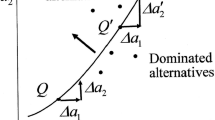Abstract
This paper investigates consumer preferences in the German statutory health insurance market. It further aims to test whether preferences differ by age and health status. Evidence is provided by a discrete choice experiment conducted in 2014 using the six most important attributes in sickness fund competition and ten random generated choice sets per participant. Price is found to be the most important attribute followed by additional benefits, managed care programmes, and distance to nearest branch. Other positive attributes of sickness funds are found to balance out a higher price, which would allow a sickness fund to position itself as high quality. However, significant differences in preferences were found between age and health status group. In particular, compromised health is associated with higher preference for illness-related additional benefits and less distance to the lowest branch, but lower preference for a lower price. Based on these differences, a distinct sickness fund offer could be constructed that would allow passive risk selection.

Similar content being viewed by others
Notes
Aspects of differentiation are further discussed in Sect. 2, where attributes for the experiment are selected.
These selective contracts are mostly based on §140a and §§ 73a to 73c Social Code Book V.
That is part-worth of the 10 Euro add-on premium level (−1.63) minus the part-worth of the no add-on premium level (62.42).
Between 2012 and 2014, the period of the present study, no sickness fund had to charge an add-on premium.
References
Enthoven, A.C.: The history and principles of managed competition. Health Aff. 12(Supplement 1), 24–48 (1993). doi:10.1377/hlthaff.12.suppl_1.24
Greß, S., Groenewegen, P., Kerssens, J.J., Braun, B., Wasem, J.: Free choice of sickness funds in regulated competition: evidence from Germany and the Netherlands. Health Policy 60(3), 235–254 (2002)
Buchner, F., Göpffarth, D., Wasem, J.: The new risk adjustment formula in Germany: implementation and first experiences. Health Policy 109(3), 253–262 (2013). doi:10.1016/j.healthpol.2012.12.001
Andersen, H.H., Grabka, M.M., Schwarze, J.: Beitragssatz, Kassenwettbewerb und Gesundheitsreform, Eine empirische Analyse. J. Econ. Stat. (Jahrbuecher fuer Nationaloekonomie und Statistik) 227(5+6), 429–450 (2007)
Schmitz, H., Ziebarth, N.R.: In absolute or relative terms? How framing prices affects the consumer price sensitivity of health plan choice. Ruhr economic papers, vol. 304. RWI, Essen (2011)
Gaßner, M., Otto, F., Ludwig, E.: Analyse der Mitgliederentwicklung sowie weiterer Kennzahlen der bundesunmittelbaren Krankenkassen ohne und mit Zusatzbeitrag bzw. Prämie. Gesundheits- und Sozialpolitik 66(5), 52–56 (2012)
Pendzialek, J.B., Danner, M., Simic, D., Stock, S.: Price elasticities in the German statutory health insurance market before and after the health care reform of 2009. Health Policy 119(5), 654–663 (2015). doi:10.1016/j.healthpol.2015.01.014
Buchmueller, T.C.: Consumer-oriented health care reform strategies: a review of the evidence on managed competition and consumer-directed health insurance. Milbank Q. 87(4), 820–841 (2009). doi:10.2307/25593647
Pendzialek, J.B., Simic, D., Stock, S.: Differences in price elasticities of demand for health insurance: a systematic review. Eur. J. Health Econ. 17(1), 5–21 (2016). doi:10.1007/s10198-014-0650-0
Cunningham, P.J., Kohn, L.: Health plan switching: choice or circumstance? Health Aff. 19(3), 158–164 (2000). doi:10.1377/hlthaff.19.3.158
Hendriks, M., de Jong, J.D., van Den Brink-Muinen, A., Groenewegen, P.P.: The intention to switch health insurer and actual switching behaviour. Are there differences between groups of people? Health Expect. 13(2), 195–207 (2009). doi:10.1111/j.1369-7625.2009.00583.x
Lako, C.J., Rosenau, P., Daw, C.: Switching health insurance plans. Results from a health survey. Health Care Anal. 19(4), 312–328 (2011). doi:10.1007/s10728-010-0154-8
Höppner, K., Buitkamp, M., Braun, B., Greß, S., Müller, R., Rothgang, H., Wasem, J.: Kassenwettbewerb: Motive für einen Kassenverbleib. In: Böcken, J., Braun, B., Schnee, M. (eds.) Gesundheitsmonitor 2004: Die ambulante Versorgung aus Sicht von Bevölkerung und Ärzteschaft, pp. 24–34. Verlag Bertelsmann Stiftung, Gütersloh (2004)
Moustafa, A.T., Hopkins, C.E., Klein, B.: Determinants of choice and change of health insurance plan. Med. Care 9(1), 32–41 (1971)
Andersen, H.H., Schwarze, J.: GKV ‘97: Kommt Bewegung in die Landschaft? Eine empirische Analyse der Kassenwahlentscheidungen. Arbeit und Sozialpolitik 52(9/10), 11–23 (1998)
Elbel, G.-K.: Das deutsche Gesundheitssystem aus Sicht der Patienten und Versicherten. Studienergebnisse 2011, 20–21 (2011)
Töpfer, A., Opitz, F.: Benchmarking mit dem Versichertenbarometer. Kundenzufriedenheit und -bindung im deutschen Krankenkassenmarkt. In: Töpfer, A. (ed.) Handbuch Kundenmanagement—Anforderungen, Prozesse, Zufriedenheit, Bindung und Wert von Kunden, 3rd edn, pp. 541–553. Springer, Berlin (2008)
Trosky, A.: Die Marke BKK: bewährt sympathisch und servicestark. Die BKK 17, 56–62 (2013)
Zok, K.: Reaktionen auf Zusatzbeiträge in der GKV. Ergebnisse einer Repräsentativ-Umfrage. WIdOmonitor 8(1), 1–8 (2011)
Birkner, G.: Kundenkompass Patientenwünsche. Aktuelle Krankenversichertenbefragung. Frankfurter Allgemeine Buch, Frankfurt am Main (2013)
Böcking, W., Pittrow, D., Kirch, W.: Die Bedeutung der Filialnetzstruktur der Gesetzlichen Krankenversicherungen für eine kunden- und patientenorientierte Versorgung. J. Public Health 12(3), 210–217 (2004)
Heute und Morgen GmbH: Trends in der GKV-Mitgliedergewinnung. Heute und Morgen Finanzmarkttrends—August 2013. http://www.gesundheitsforen.net/portal/de/gfl/wissen/studien_und_umfragen/studie__trends_in_der_gkv_mitgliederentwicklung/studie__trends_in_der_gkv_mitgliederentwicklung_1.xhtml (2013). Accessed 31 Oct 2013
Landmann, J.: Krankenkassenwettbewerb um Versicherte: Diesmal ohne Beitragssatz. In: Böcken, J., Braun, B., Landmann, J. (eds.) Gesundheitsmonitor 2009: Gesundheitsversorgung und Gestaltungsoptionen aus der Perspektive der Bevölkerung, pp. 203–220. Verlag Bertelsmann-Stiftung, Gütersloh (2009)
M+M Management + Marketing Consulting GmbH: Versichertenbefragung Handelskrankenkasse, Kassel. http://www.hkk.de/fileadmin/doc/unsere_leistungen/servicequalitaet/hkk_kundenbefragung_2006_kurzfassung.pdf (2006). Accessed 17 Dec 2013
Töpfer, A., Opitz, F.: Servicequalität aus Sicht der GKV-Versicherten gestiegen. Ergebnisse des M+M Versichertenbarometer 2010. Die Krankenversicherung 7, 265–268 (2010)
Greß, S., Höppner, K., Marstedt, G., Rothgang, H., Tamm, M., Wasem, J.: Kassenwechsel als Mechanismus zur Durchsetzung von Versicherteninteressen. In: Braun, B., Greß, S., Rothgang, H., Wasem, J. (eds.) Einfluss nehmen oder aussteigen. Theorie und Praxis von Kassenwechsel und Selbstverwaltung in der Gesetzlichen Krankenversicherung, pp. 19–89. Edition sigma, Berlin (2008)
PwC: GKV im Wettbewerb. Was ist wirklich relevant? Frankfurt am Main (2011)
Viney, R., Lancsar, E., Louviere, J.: Discrete choice experiments to measure consumer preferences for health and healthcare. Expert rev. Pharmacoecon. Outcomes res. 2(4), 319–326 (2002). doi:10.1586/14737167.2.4.319
Mechanic, D.: Consumer choice among health insurance options. Health Aff. 8(1), 138–148 (1989)
de Bekker-Grob, E.: Discrete Choice Experiments in Health Care: Theory and Applications. Erasmus University, Rotterdam (2009)
Ryan, M., Gerard, K.: Using discrete choice experiments to value health care programmes: current practice and future research reflections. Appl. Health Econ. Health Policy 2(1), 55–64 (2003)
Bridges, J.F.P., Hauber, A.B., Marshall, D., Lloyd, A., Prosser, L.A., Regier, D.A., Johnson, F.R., Mauskopf, J.: Conjoint analysis applications in health—a checklist. A report of the ISPOR Good Research Practices for Conjoint Analysis Task Force. Value Health 14(4), 403–413 (2011). doi:10.1016/j.jval.2010.11.013
Eislöffel, M.: Leistungspolitik der Kassen zwischen Evidenz und Kundenbindung. Welt der Krankenversicherung 2, 87–88 (2013)
Schaaf, M., Kade-Lamprecht, E.: Der Mensch im Mittelpunkt der GKV? Monitor Versorgungsforschung. 4, 26–31 (2011)
Nelson, P.: Information and consumer behavior. J. Polit. Econ. 78(2), 311–329 (1970)
Kuhfeld, W.F.: Efficient experimental designs using computerized searches. Sawtooth Software Research Paper Series. http://www.sawtoothsoftware.com/support/technical-papers/design-of-conjoint-experiments/efficient-experimental-designs-using-computerized-searches-1997 (1997). Accessed 21 Feb 2014
Sawtooth Software: The CBC system for choice-based conjoint analysis. Version 8. Sawtooth Software Research Paper Series. http://www.sawtoothsoftware.com/support/technical-papers/cbc-related-papers/cbc-technical-paper-2013 (2013). Accessed 28 April 2014
Johnson, F.R., Lancsar, E., Marshall, D., Kilambi, V., Mühlbacher, A., Regier, D.A., Bresnahan, B.W., Kanninen, B., Bridges, J.F.P.: Constructing experimental designs for discrete-choice experiments: report of the ISPOR Conjoint Analysis Experimental Design Good Research Practices Task Force. Value Health j. Int. Soc. Pharmacoecon. Outcomes Res. 16(1), 3–13 (2013). doi:10.1016/j.jval.2012.08.2223
Allenby, G.M., Arora, N., Ginter, J.L.: Incorporating prior knowledge into the analysis of conjoint studies. J. Mark. Res. 32(2), 152 (1995). doi:10.2307/3152044
Lenk, P.J., DeSarbo, W.S., Green, P.E., Young, M.R.: Hierarchical Bayes conjoint analysis: recovery of partworth heterogeneity from reduced experimental designs. Mark. Sci. 15(2), 173–191 (1996). doi:10.1287/mksc.15.2.173
Allenby, G.M., Rossi, P.E.: Marketing models of consumer heterogeneity. J. Econom. 89(1–2), 57–78 (1998). doi:10.1016/S0304-4076(98)00055-4
Baruch, Y.: Response rate in academic studies—a comparative analysis. Hum. Relat. 52(4), 421–438 (1999). doi:10.1177/001872679905200401
Sheehan, K.B.: E-mail survey response rates: a review. J. Comp. Med. Commun. (2001). doi:10.1111/j.1083-6101.2001.tb00117.x
Kaplowitz, M.D., Hadlock, T.D., Levine, R.: A Comparison of web and mail survey response rates. Public Opin. Q. 68(1), 94–101 (2004). doi:10.1093/poq/nfh006
Edwards, P.: Increasing response rates to postal questionnaires: systematic review. BMJ 324(7347), 1183 (2002). doi:10.1136/bmj.324.7347.1183
Mitgliederstatistik KM6. Stichtag: 1. Juli 2008, Berlin. http://www.bmg.bund.de/fileadmin/dateien/Downloads/Statistiken/GKV/Mitglieder_Versicherte/KM6-juli-08.xls. Accessed 7 Dec 2015
van de Ven, W.P.M.M, Beck, K., Buchner, F., Chernichovsky, D., Gardiol, L., Holly, A., Lamers, L.M., Schokkaert, E., Shmueli, A., Spycher, S., van de Voorde, C., van Vliet, R.C.J.A., Wasem, J., Zmora, I.: Risk adjustment and risk selection on the sickness fund insurance market in five European countries. Health Policy 65(1), 75–98 (2003). doi:10.1016/S0168-8510(02)00118-5
Drösler, S., Hasford, J., Kurth, B.-M., Schaefer, M., Wasem, J., Wille, E.: Evaluationsbericht zum Jahresausgleich 2009 im Risikostrukturausgleich. http://www.bmg.bund.de/fileadmin/dateien/Publikationen/Gesundheit/Forschungsberichte/Evaluationsbericht_zum_Jahresausgleich.pdf (2011). Accessed 10 Jan 2014
van de Ven, W.P.M.M., van Vliet, R.C.J.A.: How can we prevent cream skimming in a competitive health insurance market? In: Zweifel, P., Frech, H.E., Zweifel, P. (eds.) Health economics worldwide. Developments in health economics and public policy, vol. 1, pp. 23–46. Springer, Dordrecht (1992)
Höppner, K., Greß, S., Rothgang, H., Wasem, J.: Instrumente der Risikoselektion—Theorie und Empirie. In: Göpffarth, D., Greß, S., Jacobs, K., Wasem, J. (eds.) Risikostrukturausgleich 2006: Zehn Jahre Kassenwahlfreiheit, pp. 119–144. Asgard Verlag, St. Augustin (2006)
Gelman, A.: Struggles with survey weighting and regression modeling. Stat. Sci. 22(2), 153–164 (2007). doi:10.1214/088342306000000691
Hoffmann, F., Icks, A.: Do persons that changed health insurance differ from those who did not? The case of diabetes. Exp. Clin. Endocrinol. Diabetes 119(9), 569–572 (2011). doi:10.1055/s-0031-1275277
Werner, A., Reitmeir, P., John, J.: Kassenwechsel und Risikostrukturausgleich in der gesetzlichen Krankenversicherung—empirische Befunde der Kooperativen Gesundheitsforschung in der Region Augsburg (KORA) [Switching sickness funds and risk compensation mechanisms in the statutory health insurance system in Germany–empirical results from the cooperative health research in the region of Augsburg (KORA)]. Gesundheitswesen 67(Suppl 1), 158–166 (2005). doi:10.1055/s-2005-858261
Andersen, H.H., Grabka, M.M.: Kassenwechsel in der GKV 1997–2004. Profile—Trends—Perspektiven. In: Göpffarth, D., Greß, S., Jacobs, K., Wasem, J. (eds.) Risikostrukturausgleich 2006: Zehn Jahre Kassenwahlfreiheit, pp. 145–183. Asgard Verlag, St. Augustin (2006)
Vroomen, J.M., Zweifel, P.: Preferences for health insurance and health status: does it matter whether you are Dutch or German? Eur. J. Health Econ. 12, 87–95 (2011). doi:10.1007/s10198-010-0248-0
Paquet, R., Stein, M.: GKV-Mitglieder: preissensibel und leistungsbewusst. Die BKK. 12, 274–280 (2008)
Mitglieder, mitversicherte Angehörige und Krankenstand. Jahresdurchschnitt 2014. Ergebnisse der GKV-Statistik KM1/13, Berlin. http://www.bmg.bund.de/fileadmin/dateien/Downloads/Statistiken/GKV/Mitglieder_Versicherte/KM1_JD_2014.pdf (2015). Accessed 7 Dec 2015
Bildungsstand der Bevölkerung 2015, Wiesbaden. https://www.destatis.de/DE/Publikationen/Thematisch/BildungForschungKultur/Bildungsstand/BildungsstandBevoelkerung5210002157004.pdf?__blob=publicationFile (2015). Accessed 20 May 2016
Author information
Authors and Affiliations
Corresponding author
Appendix
Rights and permissions
About this article
Cite this article
Pendzialek, J.B., Simic, D. & Stock, S. Measuring customer preferences in the German statutory health insurance. Eur J Health Econ 18, 831–845 (2017). https://doi.org/10.1007/s10198-016-0829-7
Received:
Accepted:
Published:
Issue Date:
DOI: https://doi.org/10.1007/s10198-016-0829-7




